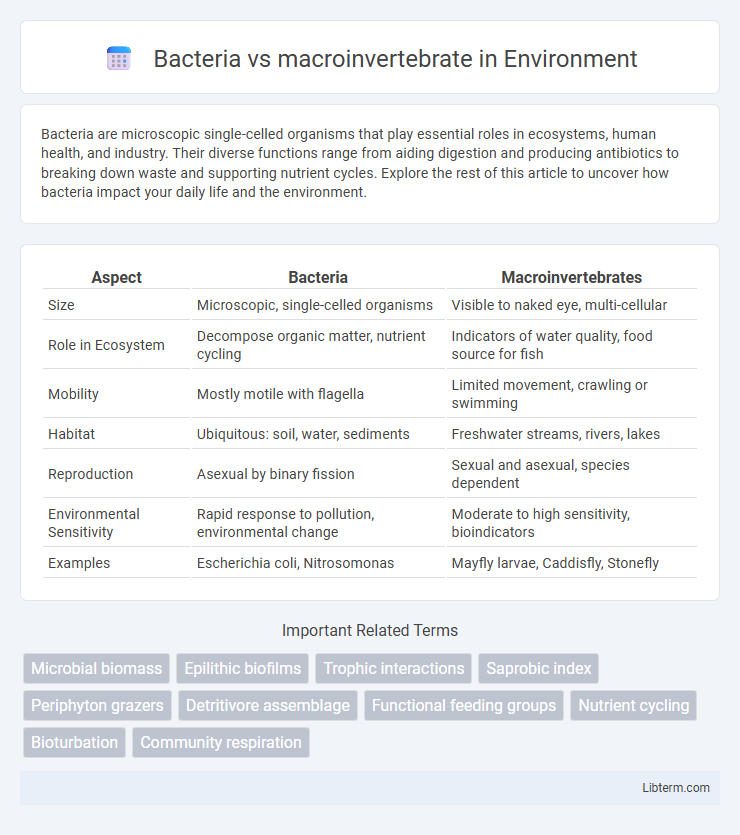Bacteria are microscopic single-celled organisms that play essential roles in ecosystems, human health, and industry. Their diverse functions range from aiding digestion and producing antibiotics to breaking down waste and supporting nutrient cycles. Explore the rest of this article to uncover how bacteria impact your daily life and the environment.
Table of Comparison
| Aspect | Bacteria | Macroinvertebrates |
|---|---|---|
| Size | Microscopic, single-celled organisms | Visible to naked eye, multi-cellular |
| Role in Ecosystem | Decompose organic matter, nutrient cycling | Indicators of water quality, food source for fish |
| Mobility | Mostly motile with flagella | Limited movement, crawling or swimming |
| Habitat | Ubiquitous: soil, water, sediments | Freshwater streams, rivers, lakes |
| Reproduction | Asexual by binary fission | Sexual and asexual, species dependent |
| Environmental Sensitivity | Rapid response to pollution, environmental change | Moderate to high sensitivity, bioindicators |
| Examples | Escherichia coli, Nitrosomonas | Mayfly larvae, Caddisfly, Stonefly |
Introduction: Bacteria vs Macroinvertebrate
Bacteria and macroinvertebrates serve as essential biological indicators in aquatic ecosystems, each reflecting different environmental conditions. Bacteria, microscopic single-celled organisms, play a crucial role in nutrient cycling and organic matter decomposition, often responding rapidly to pollution levels. Macroinvertebrates, visible to the naked eye and including insects, crustaceans, and mollusks, provide insight into long-term water quality through their diverse tolerance to pollutants and habitat changes.
Defining Bacteria and Macroinvertebrates
Bacteria are microscopic single-celled organisms that play crucial roles in nutrient cycling, decomposition, and environmental balance by breaking down organic matter and recycling nutrients in ecosystems. Macroinvertebrates are larger, multicellular animals without backbones, such as insects, crustaceans, and mollusks, commonly used as bioindicators to assess water quality and ecosystem health. Both bacteria and macroinvertebrates contribute to aquatic habitats, but bacteria operate at the microbial level, while macroinvertebrates are visible organisms influencing food webs and habitat structure.
Habitat and Environmental Roles
Bacteria thrive in diverse habitats such as soil, water, and organic matter, playing critical roles in nutrient cycling, decomposition, and bioremediation. Macroinvertebrates, found primarily in freshwater ecosystems like streams and ponds, contribute to habitat quality assessment by processing organic material and serving as bioindicators of water health. Both groups support ecosystem stability through nutrient recycling, but bacteria excel in microscopic decomposition, whereas macroinvertebrates influence sediment structure and food web dynamics.
Structural Differences
Bacteria are single-celled microorganisms lacking a defined nucleus and possessing simple structures such as a cell wall, plasma membrane, and sometimes flagella or pili. Macroinvertebrates are multicellular organisms with complex body structures, including differentiated tissues, organs, and a digestive system, often with exoskeletons or segmented bodies. The cellular complexity and size significantly distinguish bacteria from macroinvertebrates, with bacteria typically measuring 0.2-10 micrometers and macroinvertebrates ranging from millimeters to several centimeters.
Reproduction and Life Cycles
Bacteria reproduce primarily through binary fission, a rapid asexual process that allows exponential population growth and adaptation to environmental changes. Macroinvertebrates exhibit diverse reproductive strategies including sexual reproduction with distinct life stages such as egg, larva, pupa, and adult, enabling complex development and ecological specialization. The shorter and simpler bacterial life cycle contrasts with the longer, more complex life cycles of macroinvertebrates that involve metamorphosis and varied habitat requirements.
Role in Ecosystems and Food Webs
Bacteria play a crucial role in ecosystems by decomposing organic matter, recycling nutrients, and supporting primary production through nutrient cycling. Macroinvertebrates act as essential bioindicators and contribute to food webs by processing detritus and serving as prey for fish and other wildlife. Both bacteria and macroinvertebrates maintain ecosystem health by facilitating energy flow and nutrient transfer across trophic levels.
Importance in Water Quality Assessment
Bacteria serve as key indicators of microbial contamination, revealing the presence of pathogens affecting water safety and ecosystem health. Macroinvertebrates, including insects and mollusks, provide a broader assessment of water quality through their sensitivity to physical and chemical changes in aquatic habitats. Together, these bioindicators offer complementary insights essential for comprehensive water quality monitoring and management.
Adaptations and Survival Strategies
Bacteria utilize rapid reproduction, genetic mutation, and horizontal gene transfer to adapt quickly to changing environments, enabling survival in extreme conditions such as high temperature or acidity. Macroinvertebrates develop physical adaptations like exoskeletons, specialized appendages, and behavioral strategies such as burrowing or biofilm grazing to survive in aquatic habitats with variable oxygen levels and predation pressures. Both groups exhibit resilience by efficiently exploiting available resources, but bacteria rely on microscopic metabolic versatility, while macroinvertebrates depend on morphological features and ecological niches.
Human and Environmental Impacts
Bacteria play a crucial role in nutrient cycling and pollutant degradation, yet some pathogenic strains can cause significant human health risks through waterborne diseases. Macroinvertebrates serve as bioindicators of water quality, reflecting the cumulative impacts of pollution, habitat alteration, and environmental stressors on aquatic ecosystems. Monitoring both bacteria and macroinvertebrate populations provides essential data for assessing ecosystem health and managing human-induced environmental impacts effectively.
Conclusion: Comparing Micro and Macro Lifeforms
Bacteria and macroinvertebrates represent distinct biological scales with unique ecological roles and indicators of environmental health. Bacteria, as microscopic organisms, drive essential biochemical cycles such as nitrogen fixation and organic matter decomposition, while macroinvertebrates serve as bioindicators reflecting water quality and ecosystem integrity. Comparing these lifeforms highlights the complementary value of integrating microbial and macro-faunal assessments for comprehensive environmental monitoring and management.
Bacteria Infographic

 libterm.com
libterm.com